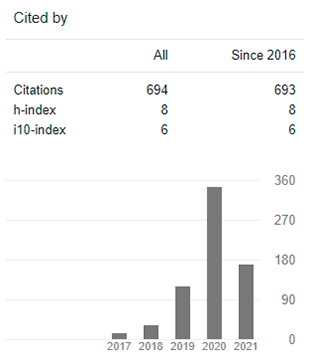Ecuadorian Interventionist Policy from the theoretical perspective of the Curse of Resources (2008-2017)
DOI:
https://doi.org/10.29394/Scientific.issn.2542-2987.2019.4.13.1.19-39Keywords:
petroleum, nonrenewable resources, politics, international interventionAbstract
This paper made an analysis of the Interventional Policy of the period comprised by the governments of President Rafael Correa in the period 2008 to 2017, contextualized within the framework of the Theory of Curse of Resources; highlighting the active government participation in the economy in an attempt to stabilize and avoid cyclical fluctuations, especially by the historical dependence on exports of raw materials, specifically oil, historically linked to the control of private companies. It consists of a case study, which emphasizes qualitative research with a combination of quantitative resources. For this reason, methodological triangulation is resorted to; The first, from a reflective position, provides an intimate description that makes it possible to weigh the context as the meaning of events through an ethnographic vision, without falling into a simple description and refers to different orientations that contribute to a mosaic of political and economic perspectives. While, the second, offers a perspective of the reality expressed in different statistics that have been considered, such as Public Expenditure, Gross Domestic Product and Investment.
Downloads
References
Acosta, A. (2006). Breve Historia Económica de Ecuador. Novena reimpresión, ISBN: 9978-84-289-6. Quito, Ecuador: Corporación Editora Nacional.
BCE (2018). Hidrocarburos. Reporte del Sector Petrolero. Ecuador: Banco Central del Ecuador. Recuperado de: https://www.bce.fin.ec/index.php/hidrocarburos
BCE (2017). Cuestiones Económicas. Banco Central del Ecuador, 27(2), ISSN: 2477-9059. Recuperado de: https://www.bce.fin.ec/cuestiones_economicas/images/PDFS/2017/RevistaCE-vol27-2-2017.pdf
Banco Mundial (2018a,b). Inversión extranjera directa, entrada neta de capital (balanza de pagos, US$ a precios actuales). Washington, Estados Unidos: Grupo Banco Mundial. Recuperado de: https://datos.bancomundial.org/indicador/BX.KLT.DINV.CD.WD
Banco Mundial (2017a,b). Fondo Monetario Internacional, Anuario de Estadísticas de las Finanzas Públicas y archivos de datos, y estimaciones del PIB del Banco Mundial y la OCDE. Washington, Estados Unidos: Grupo Banco Mundial. Recuperado de: https://datos.bancomundial.org/
Banco Mundial (2002). Globalización, Crecimiento y Pobreza. Construyendo una economía mundial incluyente. Primera Edición, ISBN: 958-682-376-8. Washington, Estados Unidos: Banco Mundial en coedición con Alfaomega Colombiana S.A., 187 págs. Recuperado de: http://documentos.bancomundial.org/
Collier, P. (2008). The Bottom Billion Why the Poorest Countries are Failing and What Can Be Done About It. Londres, Gran Bretaña: Oxford University Press.
Dalby, S. (2009). Security and Environmental Change. First Edition, ISBN 13: 987-0-7456-4291-8; ISBN 13: 987-0-7456-4292-5. USA, EE. UU.: Polity Press.
EP PETROECUADOR (2013a,b,c). 40 años construyendo el desarrollo del país. 1972-2012. Informe Estadístico. Quito, Ecuador; EP PETROECUADOR, Empresa Pública de Hidrocarburos del Ecuador. [Documento en línea]. Recuperado de: https://www.eppetroecuador.ec/wp-content/uploads/downloads/2015/03/40-A%C3%B1os-Construyendo-el-Desarrollo-del-Pa%C3%ADs.pdf
Kalecki, M. (1956a,b). Teoría de la dinámica económica. Ensayo sobre los movimientos cíclicos y a lo largo de la economía capitalista. ISBN 10: 9681609700; ISBN 13: 9789681609702. México, D.F.: Fondo de Cultura Económica - FCE.
Kaplan, R. (1994). The Coming Anarchy. The Atlantic Monthly. EE. UU.: The Atlantic Monthly Group. Recuperado de: https://www.theatlantic.com/magazine/archive/1994/02/the-coming-anarchy/304670/
Karl, T. (1997a,b,c,d). La Paradoja de la abundancia: el auge petrolero y los Petro-Estados. Estados Unidos: University of California.
Keynes, J. (2003). Teoría General de la ocupación, el interés y el dinero. 4ª edición, Colección: Economía, ISBN: 9786071624284. México, D.F.: Fondo de Cultura Económica - FCE.
Marradi, A., Archenti, N., & Piovani, J. (2018a,b). Manual de Metodología de las Ciencias Sociales. 1era Edición, ISBN: 978-987-629-809-4. Ciudad Autónoma de Buenos Aires, Argentina: Siglo XXI Editores.
O'Donnell, G. (1978). Apuntes para una teoría del estado. Revista Mexicana de Sociología, 40(4), 1157-1199, e-ISSN: 2594-0651. Recuperado de: https://doi.org/10.2307/3539655
ONU (2018). Macroeconomía y finanzas. Nueva York, EE. UU.: Organización de las Naciones Unidas. Recuperado de: http://www.un.org/es/development/progareas/macroFin.shtml
Oszlak, O. (2007). Formación Histórica en América Latina: Elementos teóricos-metodológicos para su estudio. En Acuña Carlos, Lecturas sobre el estado y las políticas públicas: Retomando el debate de ayer para fortalecer el actual. Buenos Aires, Argentina: Proyecto de Modernización del estado, Jefatura de Gabinete de Ministros de la Nación. Recuperado de: http://www2.congreso.gob.pe/
Prebisch, R. (1981a,b). Capitalismo Periférico: Crisis y transformación. Sección de Obras de Economía, ISBN: 968-16-0819-4. México, D.F.: Fondo de Cultura Económica - FCE.
Tornell, A., & Lane, P. (1999). The Voracity Effect. The American Economic Review, 89(1), 22-46, e-ISSN: 1944-7981. Recuperado de: https://www.jstor.org/stable/116978
Published
How to Cite
Issue
Section
License
Copyright (c) 2019 INDTEC, C.A.

This work is licensed under a Creative Commons Attribution-NonCommercial-ShareAlike 4.0 International License.
The content of the journals of this site, are under a Creative Commons Attribution-Noncommercial-Share Alike 4.0 International License.













